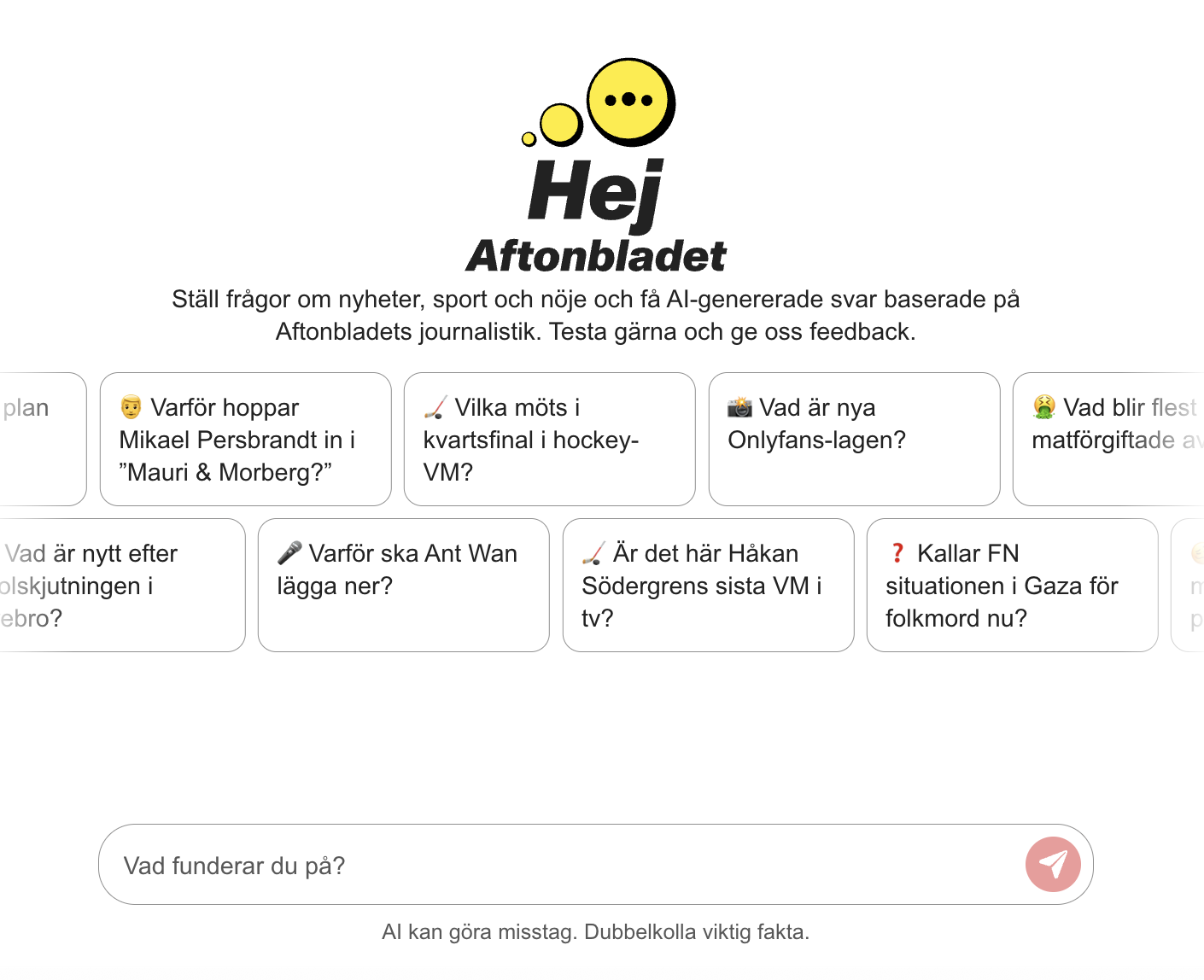What do YOU want to know?
How Sweden's largest daily newspaper built a chatbot—through collaboration between tech and editorial—that empowers the audience to choose how they want to consume journalism.
Hej Aftonbladet chatbot page on Aftonbladet's website.
Written by Martin Schori
What happens when journalism stops talking at people – and starts listening?
That simple question sparked a months-long journey that led to Hej Aftonbladet – an AI-powered chatbot that lets people interact with our journalism in 50 languages. Ask anything from “Why is electricity so expensive?” to “What’s happening in Gaza?” or even “Why is it so hard to fall in love?” And you’ll get a clear, trustworthy answer – grounded in the work of real journalists.
It may sound simple. But it changed how we think about news.
At Aftonbladet, we’ve spent decades pushing out breaking news to millions. But more and more, we noticed something: younger readers weren’t tuning in. Many didn’t feel at home in our headlines. Others were overwhelmed, confused, or just... too busy.
So we looked at a new technology that is currently sweeping over the world. And flipped the perspective.
What if the starting point wasn’t what we want to tell, but what they want to know?
Hej Aftonbladet became our answer: a friendly, fast, multilingual way into the news. Built on the past three years of our reporting. Updated daily. Free to try. And designed not just to inform – but to invite to a conversation.
We used Retrieval Augmented Generation (RAG) models, worked hard to eliminate hallucinations, and fed the chatbot with articles curated and fact-checked by our newsroom. It’s technically advanced – and we’re proud of that.
Hej Aftonbladet chatbot page on Aftonbladet's website.
Here are the details:
The chatbot is a Retrieval Augmented Generation (RAG) solution built on OpenAI’s GPT-4o and uses two vector databases to retrieve relevant information and answer user questions effectively.
One database stores Aftonbladet articles, updated in real time as new content is published. The second database contains supplementary information, such as facts about Aftonbladet, the chatbot itself, and general knowledge to handle questions not covered by the articles.
The chatbot is prompted to use only facts from Aftonbladet’s own databases and not rely on its own knowledge, which protects it from hallucinations.
In addition to these databases, the chatbot integrates with Application Programming Interfaces (APIs) for sports results and other internal data sources. We’ve also implemented key features like guardrails, question classification, and intelligent routing of questions so that the correct data source is used for each question. A robust back office system supports monitoring chat activity, analyzing statistics, managing database content, and fine-tuning prompts and other configurations.
But here’s the real secret: we didn’t build it for the tech. We built it for the people.
We tested it with users, not just engineers. We involved designers, editors, and young readers. We curate “top of mind” questions based on Google trends and newsroom judgment. And we focus on clarity, relevance, and tone – not just functionality.
Because people don’t just want information. They want to understand.
What we’ve learned
Curiosity is the new homepage. When people ask their own questions, engagement deepens.
News needs to feel personal. The most popular prewritten questions? Not war or politics – but football and celebrity relationships.
Friction kills curiosity. So we let people try the service without logging in. But if they want to ask their own questions, they get 30 per day – and full access to our journalism.
Language matters. By offering 50 languages, we reached users who had never felt included in Swedish news before. Nearly a quarter of our early users were under 36.
Right now, Hej Aftonbladet is live on our homepage, in articles, and in our app. It’s connected to sports scores, weather, even recipes. But the bigger shift is in how we think about our role.
We're no longer just broadcasting the news. We're building tools to help people navigate it.
From passive readers to active participants.
From confusion to clarity.
From “Here’s what we think is important” to “What do you want to know?”
And that, we believe, is what journalism should feel like in 2025.
About Aftonbladet
Aftonbladet is Sweden’s largest daily newspaper by readership, founded in 1830 and headquartered in Stockholm. It is owned by the Norwegian media group Schibsted and reaches more than 3.5 million users daily.



